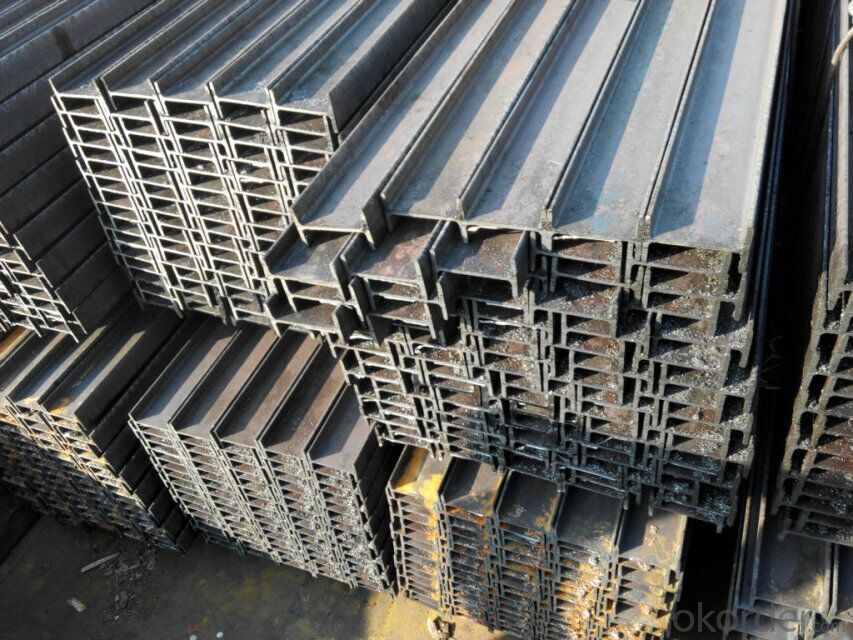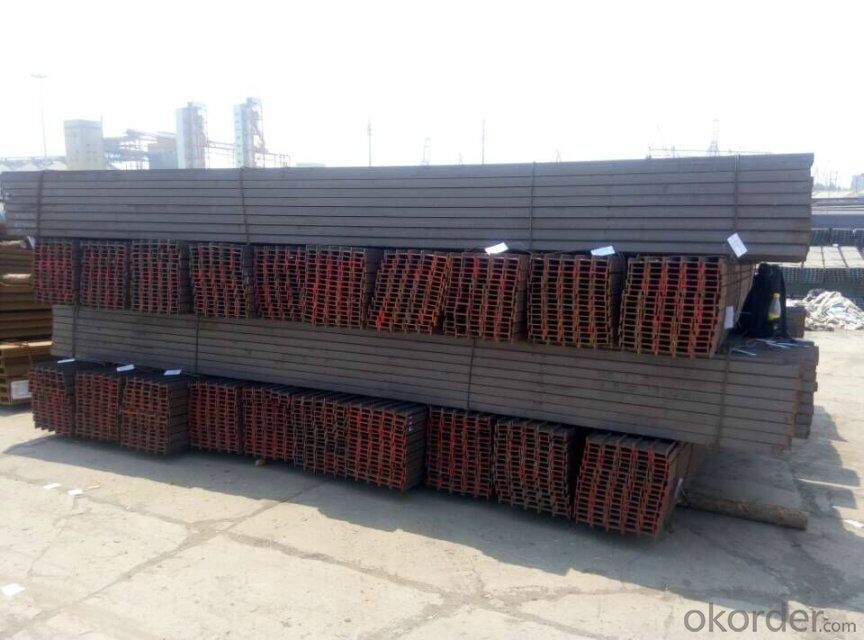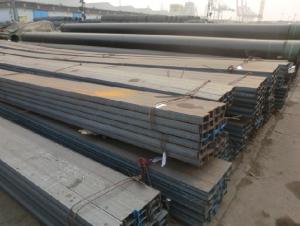Steel I-Beam with Good Quality and Price from China
- Loading Port:
- Tianjin
- Payment Terms:
- TT OR LC
- Min Order Qty:
- 25 m.t
- Supply Capability:
- 10000 m.t/month
OKorder Service Pledge
OKorder Financial Service
You Might Also Like
Item specifice
Okorder.com is a professional materials & equipment supplier & manufacturer, offers integrated one-stop services including real-time quoting and online cargo tracking. We are funded by CNBM Group, a Fortune 500 enterprise and the largest materials & equipment firm in China.
Product Applications:
IPE/IPEAA Beam Steel are widely used in various construction structures, bridges, autos, brackets, mechanisms and so on.
Product Advantages:
OKorder's Steel I-Beams are durable, strong, and resist corrosion.
Main Product Features:
· Premium quality
· Prompt delivery & seaworthy packing (30 days after receiving deposit)
· Corrosion resistance
· Can be recycled and reused
· Mill test certification
· Professional Service
· Competitive pricing
Product Specifications:
1. Product name: IPE/IPEAA Beam Steel
2. Standard: EN10025, GB Standard, ASTM, JIS etc.
3. Grade: Q235B, A36, S235JR, Q345, SS400 or other equivalent.
4. Length: 5.8M, 6M, 9M, 10M, 12M or as your requirements

Section | Standard Sectional Dimensions(mm) | ||||
h | b | s | t | Mass Kg/m | |
IPE80 | 80 | 46 | 3.80 | 5.20 | 6.00 |
IPE100 | 100 | 55 | 4.10 | 5.70 | 8.10 |
IPE120 | 120 | 64 | 4.80 | 6.30 | 10.40 |
IPE140 | 140 | 73 | 4.70 | 6.90 | 12.90 |
IPE160 | 160 | 82 | 5.00 | 7.40 | 15.80 |
IPE180 | 180 | 91 | 5.30 | 8.00 | 18.80 |
IPE200 | 200 | 100 | 5.60 | 8.50 | 22.40 |
IPE220 | 220 | 110 | 5.90 | 9.20 | 26.20 |
IPE240 | 240 | 120 | 6.20 | 9.80 | 30.70 |
IPE270 | 270 | 135 | 6.60 | 10.20 | 36.10 |
IPEAA80 | 80 | 46 | 3.20 | 4.20 | 4.95 |
IPEAA100 | 100 | 55 | 3.60 | 4.50 | 6.72 |
IPEAA120 | 120 | 64 | 3.80 | 4.80 | 8.36 |
IPEAA140 | 140 | 73 | 3.80 | 5.20 | 10.05 |
IPEAA160 | 160 | 82 | 4.00 | 5.60 | 12.31 |
IPEAA180 | 180 | 91 | 4.30 | 6.50 | 15.40 |
IPEAA200 | 200 | 100 | 4.50 | 6.70 | 17.95 |
5.Color marking: There will be color marking on both end of the bundle for the cargo delivered by bulk vessel. That makes it easily to distinguish at the destination port.
Tag mark: there will be tag mark tied up on the bundles. The information usually including supplier logo and name, product name, made in China, shipping marks and other information request by the customer.
If loading by container the marking is not needed, but we will prepare it as customer request.
6. Shipment: In containers or in bulk cargo
FAQ:
Q1: Why buy Materials & Equipment from OKorder.com?
A1: All products are carefully selected from China's most reliable manufacturing enterprises. Through its ISO certifications, OKorder.com adheres to the highest standards and a commitment to supply chain safety and customer satisfaction. We can guarantee the quality!
Q2: How do we guarantee the quality of our products?
A2: We have established an advanced quality management system which conducts strict quality tests at every step, from raw materials to the final product. At the same time, we provide extensive follow-up service assurances as required.
Q3: Can you offer the third part inspection certificates ?
A3: Yes, we can apply third part inspection before shipping, such as SGS, BV, etc .
Images:


- Q:How do you determine the appropriate size and shape of a steel I-beam for a specific application?
- Several key factors need to be considered when determining the appropriate size and shape of a steel I-beam for a specific application. The first step is to understand the load requirements, including the magnitude and distribution of the load that the I-beam will bear. Engineers typically consult structural design codes and standards, such as the AISC Manual, to determine the appropriate size. These codes provide guidelines and equations to calculate the required section modulus and moment of inertia for a given load. The shape of the I-beam is also crucial in meeting the application's requirements. Different shapes, such as W-shapes, S-shapes, and HP-shapes, offer different properties in terms of strength, stiffness, and resistance to bending and deflection. Aside from load requirements, other factors to consider include the available space for installation, the type of support structure, and the desired aesthetic appearance. It is highly recommended to consult with a structural engineer or a professional familiar with steel beam design to ensure the selection of the appropriate size and shape for the specific application.
- Q:What are the different types of steel I-beam support systems?
- In construction and structural engineering, there are various steel I-beam support systems commonly utilized. Here are some of the most prevalent types: 1. Rolled I-Beams: These I-beam support systems serve as the fundamental and widely employed type. They are produced by rolling steel plates into the shape of an I-beam, featuring different dimensions and load-bearing capacities. 2. Welded I-Beams: To create a larger and sturdier beam, these support systems are crafted by welding together two or more rolled I-beams. This technique facilitates the customization of I-beams to meet specific load-bearing requirements. 3. Composite I-Beams: By combining different materials, such as steel and concrete, composite I-beams are produced. This fusion of materials enhances the overall load-bearing capacity and structural integrity of the I-beam. 4. Box Girders: While resembling I-beams in shape, box girders possess a rectangular or box-like cross-section. They are commonly employed when greater load-bearing capacities and longer spans are necessary. Box girders can be created using steel plates or by welding multiple sections together. 5. Tapered I-Beams: Tapered I-beams have a varying depth along their length, enabling more efficient load distribution and weight reduction. These support systems find application in structures with complex or irregular load requirements. 6. Light-gauge steel I-beams: Light-gauge steel I-beams are fashioned from thinner steel plates and are commonly used in residential construction and smaller-scale projects. They are lighter and more manageable but have lower load-bearing capacities compared to heavier-gauge I-beams. These examples represent only a fraction of the diverse steel I-beam support systems available. The selection of a suitable type depends on factors like specific load requirements, span length, and overall structural design of the building or project. Consulting a structural engineer or construction professional is crucial to determine the most appropriate I-beam support system for a particular application.
- Q:Can steel I-beams be used for mezzanine floors?
- Certainly, mezzanine floors can indeed utilize steel I-beams. Given their robustness and longevity, steel I-beams find extensive application in the construction industry. Their ability to offer exceptional support and stability renders them highly suitable for bolstering mezzanine floors. Acting as primary structural components, these I-beams establish a sturdy base for the supplementary floor area. Moreover, steel I-beams can be conveniently crafted and tailored to cater to particular design specifications, thus presenting a versatile option for constructing mezzanine floors.
- Q:How do steel I-beams perform in terms of vibration resistance?
- The vibration resistance of steel I-beams is commendable. By utilizing the I-beam design, which incorporates flanges and a web, the structure achieves exceptional rigidity and strength, effectively countering bending and torsional forces generated by vibrations. This particular arrangement aids in the dispersion and dissipation of vibrations across the beam, preventing excessive bending and minimizing the likelihood of failure. Furthermore, due to the inherent high-strength nature of steel, it inherently possesses vibration damping properties, diminishing the amplitude of vibrations and their transmission through the beam. Consequently, I-beams prove to be highly suitable for applications necessitating strong vibration resistance, such as the construction of bridges, skyscrapers, and industrial machinery. Nevertheless, it is crucial to consider that the vibration resistance performance of steel I-beams can be influenced by various factors, including the dimensions of the beam, material properties, and the magnitude and frequency of the vibrations. Thus, it is imperative to conduct thorough engineering analysis and design evaluations to guarantee optimal vibration resistance tailored to specific applications.
- Q:What are the different types of steel connections used for I-beams in renovations?
- There are several different types of steel connections that are commonly used for I-beams in renovations. These connections are designed to provide structural support and stability to the I-beams, ensuring that they can effectively bear the weight and loads placed upon them. One common type of steel connection used in renovations is the bolted connection. This involves using bolts and nuts to secure the I-beam to other structural elements, such as columns, beams, or plates. Bolted connections are highly versatile and can be easily adjusted or modified if needed. They provide a strong and reliable connection, making them suitable for a wide range of renovation projects. Another type of steel connection is the welded connection. This involves welding the I-beam to other steel components, creating a permanent and seamless joint. Welded connections offer excellent strength and rigidity, making them ideal for heavy-duty applications. However, it is important to ensure proper welding techniques are used to maintain the integrity of the connection. In addition to bolted and welded connections, there are also specialized steel connections available for specific renovation scenarios. For instance, moment connections are used when there is a need to resist rotational forces or moments. These connections are designed to provide extra rigidity and stability to the I-beams, preventing any unwanted movement or deflection. Moreover, there are also eccentric connections that are used when the center of gravity of the I-beam does not align perfectly with the connecting element. These connections are designed to accommodate this eccentricity and ensure a secure and stable connection. Overall, the choice of steel connection for I-beams in renovations will depend on factors such as the load requirements, structural design, and specific project constraints. Consulting with a structural engineer or construction professional is essential to determine the most suitable steel connection type for a particular renovation project.
- Q:Can steel I-beams be used in high-humidity environments?
- Yes, steel I-beams can be used in high-humidity environments. Steel is known for its durability and resistance to corrosion, which makes it suitable for various conditions, including high humidity. However, it is important to ensure proper maintenance and protection of the steel beams to prevent any potential corrosion or rusting in a high-humidity environment. Applying a protective coating or using stainless steel I-beams are some ways to enhance their resistance to humidity and prevent any potential damage. Regular inspections and maintenance should also be conducted to identify and address any signs of corrosion or degradation.
- Q:What are the different types of steel reinforcements for I-beams?
- There are several types of steel reinforcements commonly used for I-beams, including plain carbon steel, low-alloy steel, high-strength low-alloy steel, and stainless steel. Each type offers specific properties and advantages depending on the required strength, durability, and corrosion resistance for the intended application.
- Q:Can steel I-beams be used in coastal or marine environments?
- Steel I-beams can indeed be employed in coastal or marine settings, provided that adequate precautions and maintenance are taken. To shield the steel from the corrosive impact of saltwater and moisture, one can apply stainless steel, galvanized steel, or other corrosion-resistant coatings. It is also crucial to conduct regular inspections and maintenance to avert any potential corrosion or harm. Furthermore, one should consider proper design aspects, like utilizing sacrificial anodes to provide additional protection against corrosion. Through implementing these measures, steel I-beams can endure the demanding conditions of coastal or marine environments.
- Q:Which bearing capacity is big, I-beam or H?
- The cross-sectional area of the same situation, steel bearing capacity is stronger, because of relatively large parts of the distribution of material force, should be less stress smaller than H material so I-beam steel section stress closer to isotensoid.
- Q:No. 20 I-beam, span 9 meters, can support the concrete roof?
- No. 20 I-beam 9 meters span, even without bearing, the naked eye can see the middle bend (waist down).
1. Manufacturer Overview |
|
|---|---|
| Location | |
| Year Established | |
| Annual Output Value | |
| Main Markets | |
| Company Certifications | |
2. Manufacturer Certificates |
|
|---|---|
| a) Certification Name | |
| Range | |
| Reference | |
| Validity Period | |
3. Manufacturer Capability |
|
|---|---|
| a)Trade Capacity | |
| Nearest Port | |
| Export Percentage | |
| No.of Employees in Trade Department | |
| Language Spoken: | |
| b)Factory Information | |
| Factory Size: | |
| No. of Production Lines | |
| Contract Manufacturing | |
| Product Price Range | |
Send your message to us
Steel I-Beam with Good Quality and Price from China
- Loading Port:
- Tianjin
- Payment Terms:
- TT OR LC
- Min Order Qty:
- 25 m.t
- Supply Capability:
- 10000 m.t/month
OKorder Service Pledge
OKorder Financial Service
Similar products
New products
Hot products
Related keywords






























